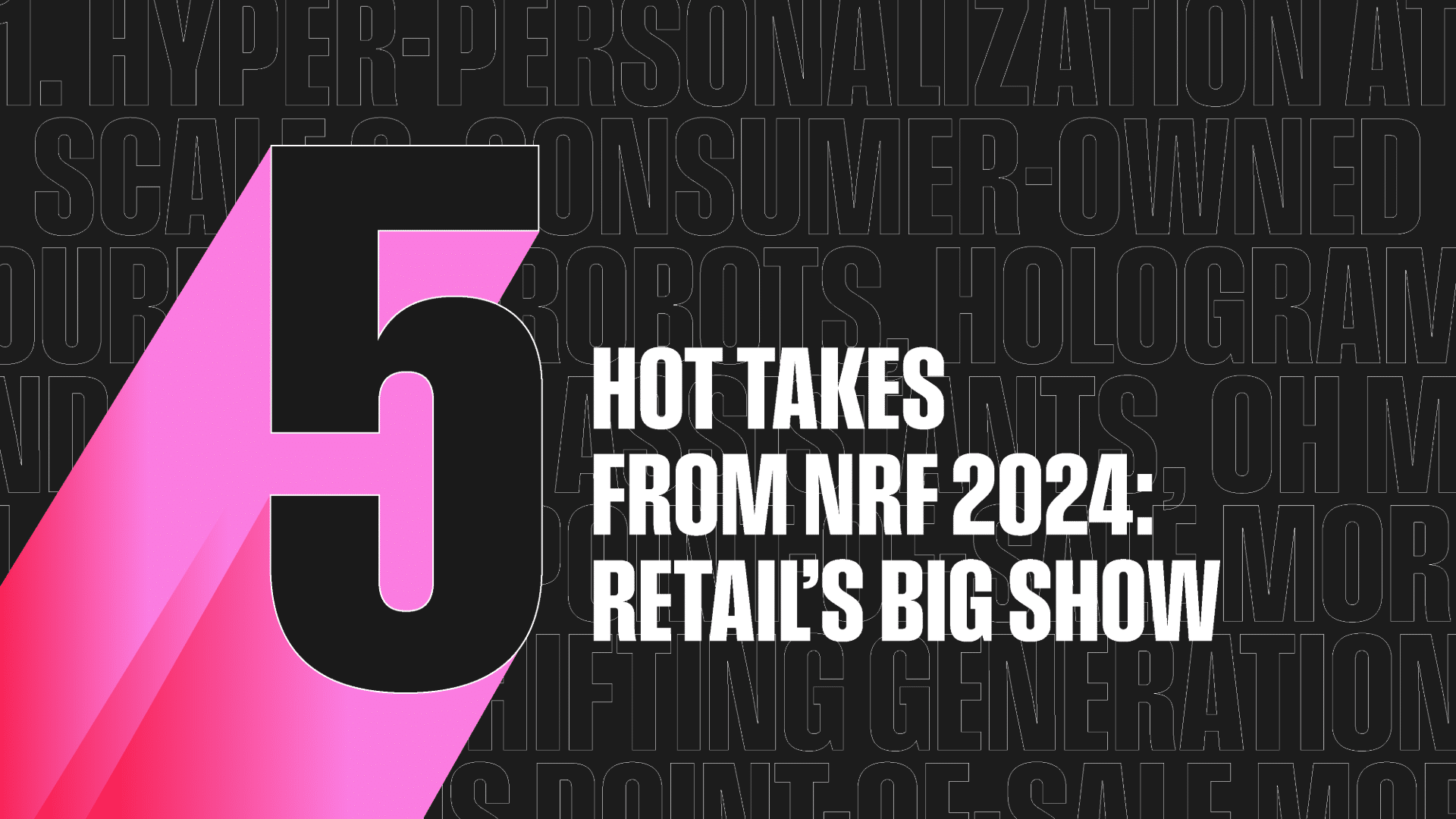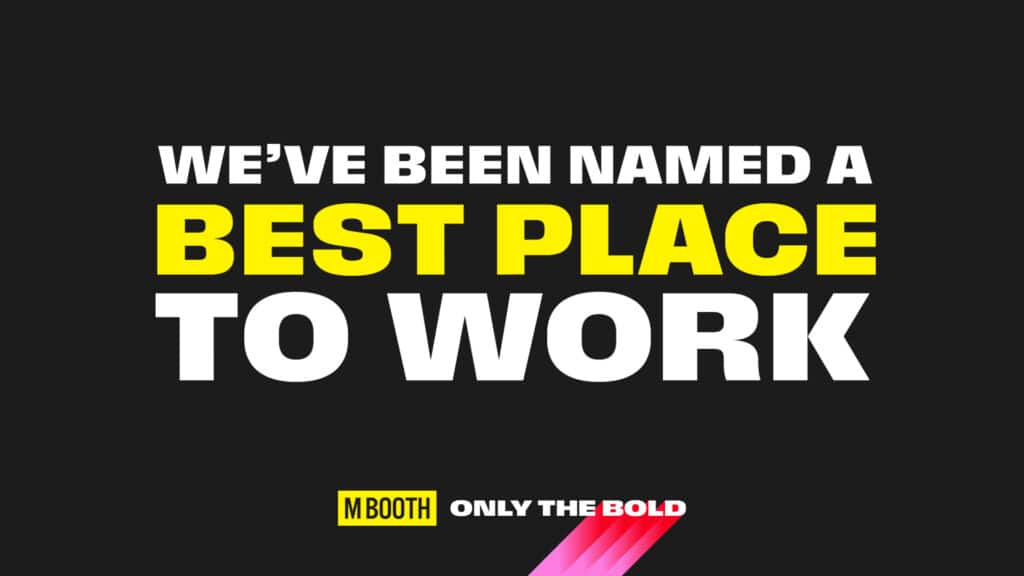Looking for trends coming out of the National Retail Federation’s Big Show last week? After hitting the floor of the Javits Center—where 40,000 people from 100 countries representing 6,200 brands came together over 190 sessions, 450 speakers, and 1,000 exhibitors (say that three times fast!)—we are here to give you five vital trends that we recommend focusing on within retail marketing right now. Not surprisingly, AI was a hot topic throughout many sessions and on the show floor. But that’s far from all.
To set the stage for the conference, NRF Chairman and President and CEO of Walmart US John Furner noted that while 2023 was filled with challenges, from inflation and high interest rates to global instability and a rise in organized retail crime, the industry is coming off a stronger-than-expected Q4. NRF Vice President Susan Reda agreed, saying the mood heading into 2024 is “guarded positivity.” CNBC senior economics reporter Steve Liesman echoed that sentiment, predicting that the economy is going to grow relatively slowly this year, but a recession isn’t likely in the cards. We were especially fond of the vision of Carla Vernon, CEO of The Honest Company: “Success is not a straight line, but more like a Candyland board. Sometimes you get a shortcut and jump ahead and other times you slide back down.”
The last few years have proven that the retail industry is incredibly resilient and with the help of technology, innovation, and leaders who are eager to embrace change, it can overcome even the biggest obstacles and evolve to meet the needs of today’s demanding shoppers.
1. HYPER-PERSONALIZATION AT SCALE
Salesforce CEO Marc Benioff probed, “Have we been using AI or has it been using us?” We all know AI requires data to work successfully, and many shoppers accept that their brand interactions are ultimately being used to serve them better. Shoppers aren’t stagnant, and there was a lot of talk about using AI to create dynamic feedback loops and analyze behavioral data, to evolve from customer segmentation and personas to individualization where the shopping ecosystem can be 1:1 at scale.
Getting real-time, in-session, in-context data to better understand a user’s behavior, preferences, and needs is empowering brands and helping them determine what kind of communications—from product recommendations to promotions to brand activations—are most likely to drive meaningful engagement and loyalty. One example: Abercrombie & Fitch’s AI stylist, in partnership with Harlem’s Fashion Row, allows consumers to search for clothing by occasion, while also gathering data. Simply prompt “I’m going on a bachelor trip to Nashville next weekend and need an outfit,” to receive custom product recommendations.
Retailers have an unprecedented opportunity to use AI to create relationships and more moments that matter to customers, but this is now the expectation. To make the most of the opportunity, create new services that are truly unique and stand out vs retrofitting AI into existing ones; Walmart’s amazing new Shop with Friends feature comes to mind. Look to incorporate brand partners to enhance the experience —just imagine shopping on your favorite retail website and suddenly your favorite Spotify playlist song comes on to make that interaction even more custom and joyful. It will be critical to unify the experience so that a customer’s behavior in one channel influences their experience in another, removing shopper frustration.
2. CONSUMER-OWNED JOURNEY
The future of retail is that retail is everywhere. Retailers need to provide a frictionless shopping experience to customers across the entire journey, from finding the right products and ease of purchase to shipment and returns. Customers want to be able to shop and engage with the brand wherever they are and have a unified omnichannel experience so that they feel like no matter where they interact with a brand—online, in-store, in-app, on social—they’re picking up where they left off.
Order delivery is a good example of where brands can give consumers more control. Both FedEx and UPS are optimizing their supply chains to turn insights into real-time intelligence to deliver a better, seamless ecommerce experience. RFID technology is providing customers with milestones that matter. Shoppers can now not only track when their order has shipped, but can see it along the delivery route to the time it arrives at their door, as well as see delays in real time. This also helps alleviate the number of calls to customer service.
Returning items continues to get easier. Brand partnerships, like the one between Kohl’s and Amazon, provide more portals for customers to drop off packages. Retail return kiosks that serve as hubs where customers can scan their items to do a self return are in the pilot stage. And a bevy of payment options, from buy-now, pay-later brands to financing options, give consumers more control over how they check out and pay for merchandise.
The key to success will be providing customers with more transparency throughout the shopping process and agency over their personal data, while also ensuring them that their privacy is being respected. Brands that let customers drive how they prefer to engage will win.
3. ROBOTS, HOLOGRAMS AND VIRTUAL ASSISTANTS, OH MY!
AI is increasingly evolving to not only solve back-of-house issues, but to also have practical applications within the physical store. This year’s inaugural Foodservice Innovation Zone featured a fry-cook robot, autonomous check-out, and refrigerated vending machines that use robotics to restock fresh food to minimize waste. Also featured was the RoboBurger, a restaurant in vending machine size, where you can get a fresh burger grilled and assembled in four minutes with the touch of a button— showcasing how retailers can add food vendors to their footprint. In the Innovation Lab lifelike holograms demonstrated how AI-generated images can serve as store greeters to answer questions and even place online orders. Ulta also shared that it’s launching a robotic eyelash extension service and piloting an automated robotic manicure.
These kinds of advanced innovations enable retailers to use technology to replace certain retail jobs and have employees take on higher-value creative tasks. That will come with an increased need to uplevel employee skills and also to train employees on how to manage other virtual “human” employees in the future.
4. MAKING POINT-OF-SALE MORE SALIENT
Online retail sales are expected to reach eight trillion dollars by 2026. Despite that, there has been a renewed focus on physical brand experiences as a critical medium to deepen engagement and relationships. Philippe Schaus, CEO of Moët Hennessy, spoke about the challenge of conveying a luxury shopping experience via the static shelving in a traditional liquor store. To justify its high price point, the brand had to reimagine and elevate the shopping experience. Their solution: to create immersive lifestyle vignettes in partnership with other luxury retailers that convey quality through experience. At Harrod’s, for example, shoppers can visit the Moët Chandon bar, complete with exclusive delicacies and luxury decor, where the brand’s entire portfolio is available to order and content communicates the story and craftsmanship behind the product. It’s a win-win solution that elevates the category, but also uses the category to elevate the retailer.
Meanwhile, Brazilian outerwear brand Centauro opened a store in the middle of a city park to put the brand in the heart of where its merchandise is used. The Centauro Arena store hosts sports clinics, offers customers the opportunity to borrow equipment to use in the park for first-hand trial, and provides equipment repairs. It’s another win-win solution, and brings the park to the store and store to the park. And Béis, the luggage brand from actress Shay Mitchell (who calls it “an on-the-go” brand), launched the Béis Motel at The Grove in L.A. as a retail pop-up complete with interactive hotel vignettes and roaming bellhops. The idea: to give consumers a view of how the products look in their natural environment.
How brands reimagine the use of brick-and-mortar spaces to give shoppers experiences that can only be found by walking in the door will remain a critical component to building community, loyalty, and brand. Think about creating engagement opportunities that can serve as unique chapters in telling a holistic brand story. Create IRL experiences that intercept customers where they are and provide in-situation context and solutions at point-of-need.
5. SHIFTING GENERATIONAL PARADIGMS
Some eye-opening data: today’s newborns are part of an exceptionally diverse generation where no single racial ethnic group will form a majority; there will soon be a shift with women on track to control more wealth than men; and it will soon be the first time in history where people over the age of 65 will comprise a greater portion of population than those under 18.
Global trend forecasting company WGSN pointed to the “Age Spectrum” and how countries are developing at different rates—some with rapidly aging societies, others with growing youth populations, all contributing to the dismantling of age stereotypes and to “Milestone Inflation,” the rise in timing for when people have the income to achieve certain milestones. In the U.S., 52 percent of people 19-29 live with their parents, meaning a delay in home buying. Gen Z is delaying childbirth and are the number-one cohort freezing their eggs (there are 97 million views on how to freeze your eggs on TikTok).
Consumers are redefining families and relationships creating new rituals like Buddymoons and Polymoons, as well as new lifestage milestones to celebrate, like Divorce Parties and Soberversaries. This gives brands more unique opportunities than ever to engage. Walmart, for example, is catering to the rise of DINKWADS (dual income no kids with a dog) by offering pet services, like in-store grooming. Consider how your brand is questioning chrono-normative expectations when marketing to customers and helping them reach new life-stage goals. Is there an opportunity to innovate product offerings and services that take an age-agnostic approach? Acknowledging new milestones and finding ways to help customers celebrate with special products and activations can only deepen brand loyalty.




